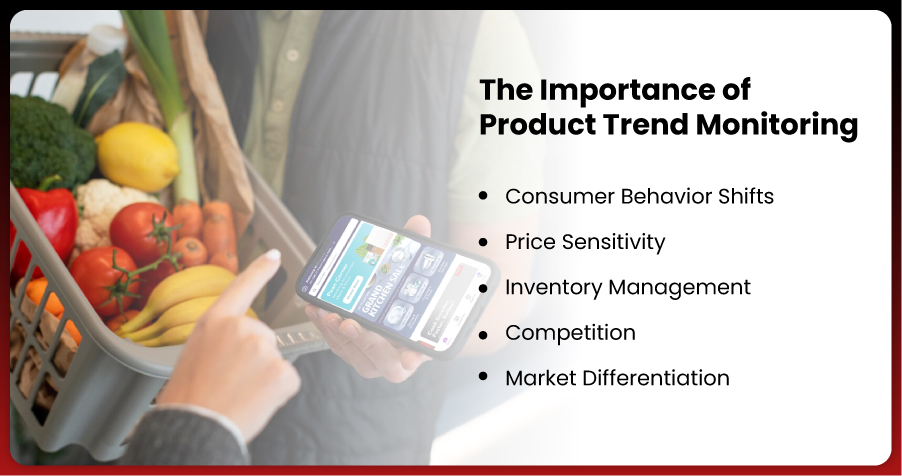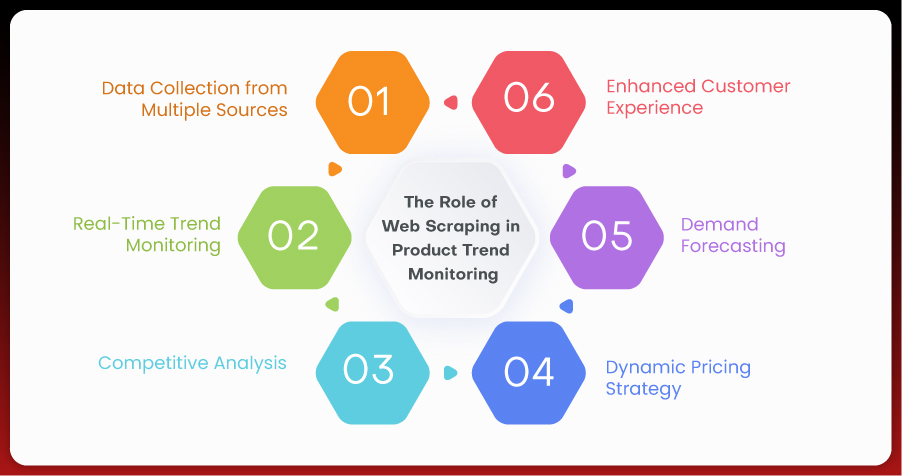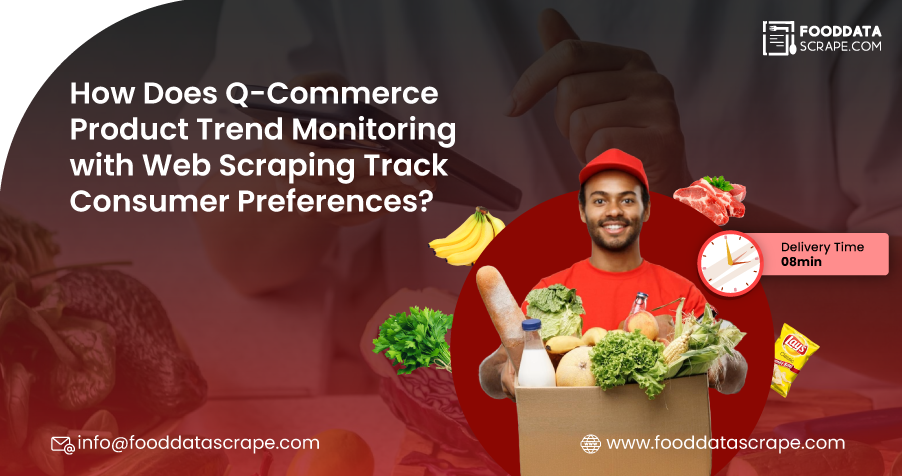Introduction
The world of e-commerce is very fast-paced and changing. For a business to remain competitive, understanding product trends is essential. Q-commerce is a rapidly growing sector within the e-commerce industry that transforms how consumers shop online. It is based on delivering products to consumers as fast as possible, in many cases, within an hour, based on the shift toward convenience and speed. For businesses in Q-commerce, tracking changing product trends is a strategy for improving customer satisfaction, driving sales, and optimizing inventory. Among the most efficient ways to track and monitor Q-commerce product trends is through web scraping technology. Q-Commerce Product Trend Monitoring with Web Scraping can collect valuable data from websites for a business. Such data might be about the availability of a product, the price, and how popular a product is in demand. It gives businesses real-time monitoring trends and an edge over competitors to make informed decisions. Moreover, the potential to Track Seasonal Product Trends from Q-Commerce Platforms enables businesses to change their products according to the season when demand rises. Web Scraping Quick Commerce Data ensures businesses have the most up-to-date insights, allowing them to adapt strategies quickly in a dynamic market.
Understanding Quick Commerce (Q-Commerce)

Quick commerce, also called "instant delivery" or "ultra-fast delivery," responds to the growing demand for fast and convenient delivery services. Unlike the traditional e-commerce model, which takes days for delivery, Q-commerce delivers orders in minutes to hours, ideal for perishable goods, groceries, and essentials. Some of the major players in this space are Blinkit, Zepto, and Instamart. They offer customers an on-demand shopping experience with quick delivery times in an hour. This business model is dependent on efficiency in sourcing products, managing inventory, and delivery logistics. E-commerce businesses must monitor and correct product offerings based on real-time demand, competitor activity, and changing market trends. At this juncture, the need to Monitor Product Trends Across Q-Commerce Websites becomes critical. Businesses can use the most advanced technology to Extract Q-Commerce Product Trends for Seasonal Analysis of consumer behavior changes. With Grocery & Supermarket Data Scraping Services , firms will track stock levels, pricing trends, and customer preferences for strategic decisions.
Gain Insights on Q-Commerce Data Scraping with Food Data Scrape. Optimize Your Strategy Today!
The Importance of Product Trend Monitoring

Product trend monitoring in Q-commerce enables businesses to observe real-time fluctuations in customer preferences, buying behaviors, and market demands. Understanding these trends allows Q-commerce platforms to optimize product assortments, adjust pricing strategies, and anticipate shifts in consumer behavior.
Several key factors make product trend monitoring critical in the Q-commerce space:
- Consumer Behavior Shifts: Consumer preferences can change rapidly, especially in industries like food delivery, groceries, and personal care products. Q-commerce companies must stay attuned to these changes to meet evolving demand.
- Price Sensitivity: Price competition is fierce in Q-commerce. By tracking product prices across multiple platforms, businesses can identify pricing trends and adjust their strategies to stay competitive.
- Inventory Management: In an industry where rapid delivery is the key to success, inventory management is crucial. Monitoring product trends can help Q-commerce platforms anticipate high-demand products and ensure they have the necessary stock.
- Competition: The Q-commerce market is highly competitive, with companies constantly launching new products, offers, and services. Monitoring trends helps businesses identify competitors' moves and adjust their strategies accordingly.
- Market Differentiation: By staying updated with the latest trends, businesses can offer unique products or bundles, setting themselves apart from the competition and meeting unmet customer needs.
The Role of Web Scraping in Product Trend Monitoring

Web scraping is a powerful tool used to automate the process of collecting data from websites. It extracts relevant information from e-commerce platforms, online stores, and other sources, enabling businesses to track various aspects of the market, such as pricing, availability, and product descriptions.
The use of Scraping Seasonal Product Trends on Q-Commerce Platforms involves several critical aspects:
• Data Collection from Multiple Sources: To effectively monitor product trends, Q-commerce businesses need to track various data points across multiple platforms, including competitors' websites, marketplaces, and social media. Web scraping allows for the simultaneous automation of data extraction from numerous sources. This enables businesses to monitor the pricing, availability, and popularity of specific products in real-time, ensuring they stay updated on shifts in demand.
For example, businesses can scrape data from platforms like Blinkit, Zepto, or Instamart to track the most popular products in their respective categories, assess which items are frequently out of stock, and determine when prices fluctuate. Scraping data from competitors' sites allows businesses to stay competitive by offering similar or better products at comparable prices.
• Real-Time Trend Monitoring: In Q-commerce, trends can change rapidly. Yesterday's high-demand products may show a sharp decline in interest today, and new items can suddenly surge in popularity. Web scraping facilitates real-time trend monitoring by continuously collecting and analyzing data.
For instance, if a particular product—a new brand of protein shake—becomes increasingly popular in one region, web scraping can track this trend and alert businesses to the surge in demand. By monitoring how quickly the product sells and whether it is available in competitor inventories, businesses can decide whether to introduce similar products to their Q-commerce platforms or adjust pricing and stock levels to meet the demand.
• Competitive Analysis: In the Q-commerce space, competition is fierce, and businesses need to monitor their rivals' offerings closely. Web scraping can provide a detailed competitive analysis by extracting data on product offerings, promotions, and pricing strategies from competitor websites.
For example, scraping competitor platforms can reveal what types of deals or discounts are being offered on specific products, how competitors are bundling products, and whether they are running promotions for specific times of the day or week. This data can help businesses adjust their strategies to remain competitive, such as offering similar or better discounts or focusing on product categories that are underrepresented in the market.
• Dynamic Pricing Strategy: Pricing is one of the most critical factors in the Q-commerce industry. Because customers are often price-sensitive, businesses must carefully monitor product prices to ensure they are offering competitive rates. Web scraping allows businesses to collect price data from various platforms in real-time, enabling them to adjust their prices dynamically based on market conditions.
For instance, if a competitor increases the price of a specific item due to supply shortages, a Q-commerce platform can use web scraping to detect this change and immediately adjust its pricing to offer a more competitive rate. Scraping price data from multiple platforms helps businesses identify patterns, such as which products tend to see price drops during specific seasons or holidays, allowing them to plan promotions more effectively.
• Demand Forecasting: Q-commerce businesses can forecast future product demand by analyzing historical data collected through web scraping. Web scraping allows for aggregating vast amounts of data over time, providing insights into seasonality, customer preferences, and buying behaviors.
For example, suppose a specific category of products—such as snacks or beverages—experiences a surge in demand every summer. In that case, businesses can use this information to plan their inventory and marketing strategies. Web scraping can also help identify emerging trends, such as the rise of a new dietary trend, which might increase demand for certain health-related products.
• Enhanced Customer Experience: By monitoring product trends through web scraping, businesses can ensure that they offer various products aligned with customer preferences. This not only improves inventory management but also enhances the customer experience. When customers find what they are looking for quickly and at competitive prices, they are more likely to return and make repeat purchases.
Moreover, real-time data collection allows businesses to optimize the shopping experience by offering personalized recommendations based on trends. For example, if a customer frequently purchases specific product categories, businesses can use scraping data to recommend related items that are currently trending in that category.
Legal and Ethical Considerations in Web Scraping

While web scraping offers significant advantages in monitoring product trends, businesses must adhere to legal and ethical standards. Some websites have terms of service that forbid scraping, and violating these terms can lead to legal issues. Additionally, businesses must be mindful of data privacy regulations such as the General Data Protection Regulation (GDPR) in the European Union and other data protection laws. It's crucial to implement ethical scraping practices, such as ensuring that the scraping process does not overload websites' servers, respecting the website's robots.txt file (which specifies which parts of the site can be scraped), and anonymizing data when necessary to protect users' privacy. Businesses can ensure compliance by using Q-Commerce Seasonal Product Data Extraction Services while gaining valuable insights. Leveraging Grocery Delivery Scraping API Services also helps businesses automate data collection responsibly. Additionally, businesses can utilize a Grocery Price Dashboard to visualize and analyze the extracted data effectively, ensuring they stay competitive while following ethical guidelines.
Conclusion
E-commerce is a rapidly growing sector driven by consumer demand for fast, on-demand shopping. To stay competitive, businesses must use technologies like web scraping to monitor real-time product trends. By analyzing data from multiple sources, businesses gain insights into customer behavior, pricing, and competitor strategies, optimizing inventory and pricing. Grocery Price Tracking Dashboard enables businesses to track price fluctuations and adjust strategies accordingly. Web scraping enables quick adaptation to market changes, making it an essential tool for Q-commerce businesses. With Grocery Pricing Data Intelligence , businesses can make informed pricing decisions and improve their competitive positioning. By staying informed on competitor pricing, Q-commerce companies can maintain an edge and better serve their customers. Web scraping ultimately provides the agility needed to thrive in this fast-paced market.
Are you in need of high-class scraping services? Food Data Scrape should be your first point of call. We are undoubtedly the best in Food Data Aggregator and Mobile Grocery App Scraping service and we render impeccable data insights and analytics for strategic decision-making. With a legacy of excellence as our backbone, we help companies become data-driven, fueling their development. Please take advantage of our tailored solutions that will add value to your business. Contact us today to unlock the value of your data.
























































































